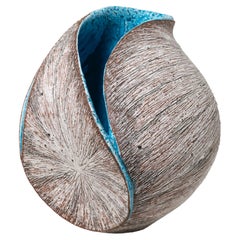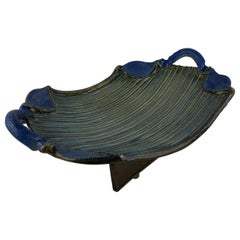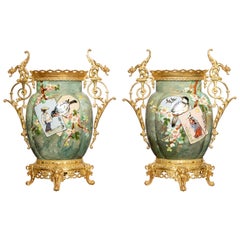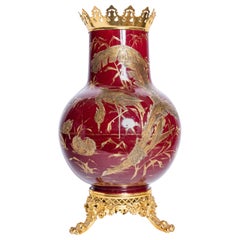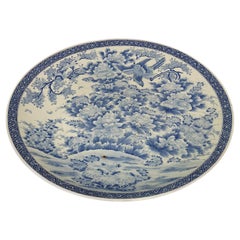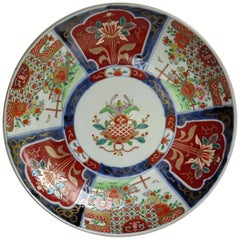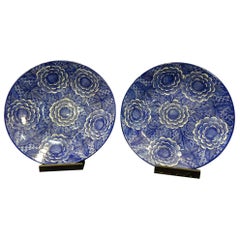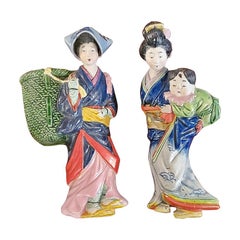Ceramics on Sale
5
1
1
to
3
1
7
7
7
247
117
80
70
62
28
19
14
10
8
5
4
4
2
2
1
3
2
2
1
1
7
2
2
1
1
4
4
3
3
3
1
1
1
Sale Items
Style: Japonisme
Tanoue Shinya Eggshell Vessel Kara Shell vase, 2011 Original artist box
By Tanoue Shinya
Located in Uccle, BE
Tanoue Shinya, is a ceramic artist from Kyoto. His work is already placed in the Museum of Kyoto and the Hyogo Ceramic Art Museum as well as being shown at US museums (Cincinnati, P...
Category
21st Century and Contemporary Japanese Japonisme Ceramics
Materials
Ceramic
A Théodore Deck (1823-1891) Enamelled Faience Soliflore Vase circa 1875
By Theodore Deck
Located in Saint-Ouen, FR
Théodore DECK (1823-1891)
A polychromatic enamelled earthenware soliflore and quadrangular shape vase with Sino-Japanese inspiration design of flowers and geometrical friezes all around.
Impressed uppercase mark "TH.DECK" under the base.
Circa 1875
Born in Guebwiller in Alsace, Théodore Deck trained as a ceramist in his home region, then in Germany. He went into partnership with his brother, Xavier Deck, to create his own factory in Paris in 1858. At the Exhibition of Industrial Arts in 1864, he presented pieces covered with transparent enamels that were not cracked, and then made his first attempts at reliefs under transparent enamels. He developed a bright turquoise color, famously renowned as "Bleu Deck". It is this nuance that we find on the salamander represented on this vase. In 1887 he published a treatise entitled "La Faïence", in which he explained some of his discoveries. That same year, he became director of the Manufacture de Sèvres.
Theodore Deck (1823-1891) is a French ceramist born in Guebwiller in Alsace. He is passionate about chemistry and the physical sciences. In 1841, he joined the master stove maker Hügelin father as an apprentice in Strasbourg. In two years, he learned of the methods inherited from the 16th century, such as the encrustation of colored pastes in the style of Saint-Porchaire. This apprenticeship did not prevent him from spending his free time draw-ing or modeling clay in the studio of sculptor André Friederich. Escaping military service, he made a tour of Germany as is the tradition with fellow Alsatian stove-makers. The quality of his work allows him to obtain important orders in Austria for the castles of the provinces and the imperial palaces, in particular for the palace of Schönbrunn. He continues his journey in Hungary to Pest, to Prague, then, going north through Dresden, Leipzig, Berlin and Hamburg. On the strength of his apprenticeship, he arrived in Paris in 1847. Recommended by Hügelin, he went to the stove factory of the Bavarian potter Vogt, located rue de la Roquette. The Revolution of 1848 interrupts production and Deck decides to return to his hometown. His family then advised him to set up a small terracotta workshop: he made a few busts, statuettes, vases, lamps and copies of famous antiques there. Aware that this situation would not allow him to provide for himself properly, he returned to Paris in 1851 where he was employed by the widow Dumas, daughter of the earthenware maker Vogt for whom he had worked. Hired as a foreman, he supplied the drawings and models to the workers, while working the land himself.
The following year, he made the decision to settle not far from his former employer at 20, rue de la Fontaine-au-Roi, probably using his ovens. His brother, Xavier Deck, joins him. It was officially in 1858 that the Deck brothers created their business and settled in Paris at 46, boulevard Saint-Jacques. Initially, the brothers only carry out coatings for stoves. But the business is going so well that barely a year after their installation, they want to diversify their production and engage in ceramics for the cladding of buildings as well as in shaped parts. Deck is interested in politics. In 1870, he opted for French nationality and was elect-ed deputy mayor in the 15th arrondissement of Paris.
In 1861, at the Salon des arts et industries de Paris, which was held on the Champs-Élysées, Théodore Deck exhibited his works for the first time: these were pieces with an inlay decoration called “Henri II” and others. pieces covered with turquoise blue enamel or decoration in the style of Iznik ceramics.If he wins a silver medal, reviews are mixed, however. The following year, on the occasion of the Universal Exhibition of 1862 in London, he won over English customers. He surprised by presenting, like the previous year, his Alhambra Vase...
Category
Antique 1870s French Japonisme Vases
Materials
Faience
Stunning Midcentury Japanese Inspired French Decorative Object, Signed Forestier
Located in Miami, FL
Stunning French ceramic decorative object inspired by Japanese pottery designs with wonderful prominent blue and green hues. The shape and colors makes this piece exceptionally inter...
Category
Mid-20th Century French Japonisme Vases
Materials
Ceramic
Pair of Glazed Ceramic and Gilt Bronze Vases, France, Late 19th Century
Located in Buenos Aires, Buenos Aires
Pair of glazed ceramic and gilt bronze vases, France, late 19th century.
Category
Antique 1890s French Japonisme Vases
Materials
Bronze
Ceramic and Gilt Bronze Vase by Sarreguemines, France, circa 1900
By Sarreguemines
Located in Buenos Aires, Buenos Aires
Ceramic and gilt bronze vase by Sarreguemines, France, circa 1900.
Category
Early 20th Century French Japonisme Vases
Materials
Bronze
Massive Antique Japanese Arita Porcelain Emperor Meiji
By Arita
Located in Hillringsberg, SE
This very large plate made in Japan during the Emperor Meiji time 1868-1912. Wonderful blue pattern on fine porcelain.
There is a crack that’s shown thro...
Category
Antique 19th Century Japanese Japonisme Ceramics
Materials
Ceramic
Japanese Style Ceramic Cup Takuya Hamajima Contemporary Zen
Located in Shibuya-ku, Tokyo
Japanese style cup made of ceramic and wood.
Wood is zelkova and ceramic with zelkova ash glaze.
Category
21st Century and Contemporary Japanese Japonisme Ceramics
Materials
Wood, Ceramic
Related Items
A Japanese Meiji Period Patinated Bronze Censer
Located in Stamford, CT
A Japanese Meiji censer rising on three stylized Foo Dogs feet with Frog form handles. Censer having exceptional patination.
Acquired from Michael Goedh...
Category
Antique Late 19th Century Japanese Meiji Planters, Cachepots and Jardini...
Materials
Bronze
Japanese Porcelain Charger finely Hand Painted, Meiji Period circa 1880
Located in Lincoln, Lincolnshire
This is a good quality, hand decorated Japanese porcelain charger, large plate or bowl with an Imari pattern, dating to the late 19th centur...
Category
Antique Late 19th Century Japanese Meiji Ceramics
Materials
Porcelain
Wide Sandstone Vessel Vase by Moïo Studio
Located in Geneve, CH
Wide Sandstone Vessel vase by Moïo Studio
Unique Piece
Dimensions: W 38 x D 38 x H 32 cm
Materials: White glaze and porcelain on tan stoneware
Moïo Studio is the Berlin-based c...
Category
2010s German Post-Modern Ceramics
Materials
Stoneware
19th Century Spanish Green Glazed Earthenware Jar
Located in Marbella, ES
19th Century Spanish green glazed earthenware jar
Category
Antique Mid-19th Century Spanish Planters, Cachepots and Jardinières
Materials
Iron
Large Pair of Rococo Style Gilt Bronze and Blue Ceramic Vases
Located in London, GB
The two vases are of large, ovoid form, and feature fluted bodies which are crafted in ceramic with a mottled blue colouring. The vases are mounted with twin gilt bronze scrolling ha...
Category
Early 20th Century French Rococo Vases
Materials
Ormolu
Antique Italian Maiolica Classical Painted Vase 19th Century
Located in Bishop's Stortford, Hertfordshire
A stunning and rare antique Italian Maiolica pottery triple gourd vase hand-painted with classical stylised figurative and scroll designs in typical ...
Category
Antique 19th Century Italian Vases
Materials
Maiolica, Pottery
Late 19th Century South Italian Antique Majolica Two Shelves with Vase
Located in Casale Monferrato, IT
This pair of majolia shelves with vase is beautiful and refined. Characterized by a rich decoration and bright colors of baroque taste typical of Sicilian production in southern Ital...
Category
Antique 1880s Italian Vases
Materials
Maiolica
H 14.18 in W 10.24 in D 7.49 in
Royal Copenhagen, Malmer & Thorsson, Faience Vase, Denmark, circa 1960's
By Royal Copenhagen, Ellen Malmer
Located in Chatham, ON
ROYAL COPENHAGEN - Ellen Malmer/designer - Nils Thorsson/shape designer - Mid Century Modern - Baca series - Aluminia faience vase number 635/3121 - signed on the base ROYAL COPENHAG...
Category
Mid-20th Century Danish Scandinavian Modern Vases
Materials
Porcelain
Art Déco Turquoise Faience Vase, France, 1940s
Located in Firenze, IT
Art Deco turquoise globular vase.
Faience
France 1940s
Measures : 24 cm Height - diameter. 18 cm
Conditions: excellent.
Category
Vintage 1940s French Art Deco Vases
Materials
Ceramic
Art Nouveau French Clement Massier Vase, 19th Century
By Clement Massier
Located in Bishop's Stortford, Hertfordshire
A stunning Art Nouveau French twin handled earthenware vase by Clement Massier decorated with brown, yellowand blue streaked glazes. The vase has an impressed CLEMENT MASSIER GOLFE JUAN.
Category
Antique Late 19th Century French Art Nouveau Ceramics
Materials
Earthenware
Pair 19th Century Delft Hand-Painted Blue & White Vases
By Delft
Located in Dallas, TX
Pair 19th century Delft hand-painted blue & white vases are a splendid collectible that was created for the lucrative European market during the latter 1800s, where the clay was trea...
Category
Antique 1880s Dutch Belle Époque Vases
Materials
Ceramic
19th Century French Barbotine Cylinder Vase with Gros Relief Flowers
Located in Dallas, TX
Hand-painted in France in the 1800’s, this beautiful barbotine cylinder vase features a lovely display of paper thin flowers made from kaolin clay. These gros relief flowers...
Category
Antique 19th Century French Vases
Materials
Ceramic, Clay
Previously Available Items
Imari Blue 2 Large Chargers ceramic in His Original Box, Japon, Porcelaine, 1897
By Imari Porcelain
Located in Valladolid, ES
Set of 2 amazing very large blue and white Imari chargers in original box - Japan - Meiji period (1868-1912),
circa 1897
Paire of stunning...
Category
Antique 1890s Japanese Japonisme Ceramics
Materials
Porcelain
H 2.76 in Dm 18.12 in
Pair of Vintage Japanese Porcelain Geisha Wall Pockets
Located in Dallas, TX
Presenting a gorgeous pair of vintage Japanese porcelain geisha wall pockets.
Mid-20th century, circa 1960.
The pocket on the left depicts a J...
Category
20th Century Japanese Japonisme Ceramics
Materials
Ceramic
Midcentury Ceramic Pitcher by Albert Thiry, 'circa 1960s'
By Albert Thiry
Located in London, GB
Midcentury ceramic pitcher (circa 1960s) by Albert Thiry (1932 - 2009). A classic Thiry design and decoration scheme, this pitcher's base co...
Category
Vintage 1960s French Japonisme Pitchers
Materials
Ceramic
Midcentury Ceramic Pitcher by Albert Thiry, circa 1960s
By Albert Thiry
Located in London, GB
Midcentury ceramic pitcher (circa 1960s) by Albert Thiry (1932-2009). A classic Thiry design and decoration scheme, this pitcher's base colo...
Category
Vintage 1960s French Japonisme Pitchers
Materials
Ceramic
Vintage Midcentury Pr Japanese Komainu Lion Dogs Ceramic Turquoise Green Glaze
Located in Topeka, KS
Awesome pair of vintage midcentury Japanese Komainu or Lion Dogs in ceramic with a gorgeous glaze that is primarily turquoise green but mixed with ma...
Category
Mid-20th Century Japanese Japonisme Ceramics
Materials
Ceramic
H 10.5 in W 3.75 in D 6 in
Pair of Antique Red 19th Century Satsuma Vases, Japan
By Satsuma
Located in Antwerp, BE
Antique Japonese vases with three-footed stands, marked.
Meiji period (1868-1912) of one of the best Japanese makers for export to the European market.
A pair of ceramic hand paint...
Category
Antique 1890s Japanese Japonisme Ceramics
Materials
Ceramic, Paint
Fan Shaped Imari Serving Plate, Japan, Meiji Period, 19th Century
Located in West Palm Beach, FL
Imari fan shaped Meiji Period porcelain serving plate. It has been decorated by hand in an underglaze blue and overpainted in iron red, aqua and gold. This a...
Category
Antique Late 19th Century Japanese Japonisme Ceramics
Materials
Enamel
Arita Porcelain Fish Shaped Bone or Sauce Dishes- Set of Five
By Arita
Located in West Palm Beach, FL
Set of five Japanese Arita porcelain bone or sauce dishes. They are hand painted in pastel colors each having a small painted flower on the inter...
Category
20th Century Japanese Japonisme Ceramics
Materials
Enamel
Massive Japanese Blue and White Charger with Carp Motif
By Japanese Studio
Located in Philadelphia, PA
Impressive example of 19th century Japanese porcelain art, this massive and very beautiful charger features an evocative rendition of the 'koi' or carp, with its symbolic reference t...
Category
Antique Late 19th Century Japanese Japonisme Ceramics
Materials
Porcelain
Recently Viewed
View AllMore Ways To Browse
White Canister Set
Bitossi Earthenware
17th Century Portuguese Tiles
Kakiemon Dish
Antique Salt Glazed Stoneware Crocks
Staffordshire Toby
Arabia Tile
Ceramic Mortar And Pestle
Willow Crown
Moulins Des Loups
Oriental Pheasant
Antique Rabbit Mold
Spanish Lusterware Ceramics
Green Vietri
Morandi Glass
Londi Cat
Aldo Londi Cat
Majolica Greek Key
